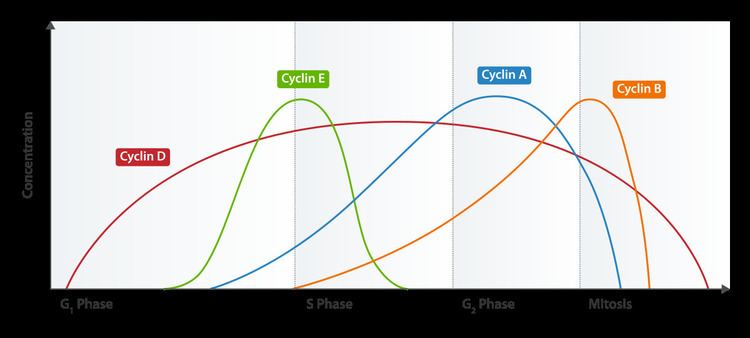 | ||
A cyclin-dependent kinase complex (CDKC, cyclin-CDK) is a protein complex formed by the association of an inactive catalytic subunit of a protein kinase, cyclin-dependent kinase (CDK), with a regulatory subunit, cyclin. Once cyclin-dependent kinases bind to cyclin, the formed complex is in an activated state. Substrate specificity of the activated complex is mainly established by the associated cyclin within the complex. Activity of CDKCs is controlled by phosphorylation of target proteins, as well as binding of inhibitory proteins.
Contents
Yeast Cell Cycle
Although these complexes have a variety functions, CDKCs are most known for their role in the cell cycle. Initially, studies were conducted in Schizosaccharomyces pombe and Saccharomyces cerevisiae (yeast). S. pombe and S. cerevisiae are most known for their association with a single Cdk, Cdc2 and Cdc28 respectively, which complexes with several different cyclins. Depending on the cyclin, various portions of the cell cycle are affected. For example, in S. pombe, Cdc2 associates with Cdk13 to form the Cdk13-Cdc2 complex. In S. cerevisiae, the association of Cdc28 with cyclins, Cln1, Cln2, or Cln3, results in the transition from G1 phase to S phase. Once in the S phase, Cln1 and Cln2 dissociates with Cdc28 and complexes between Cdc28 and Clb5 or Clb6 are formed. In G2 phase, complexes formed from the association between Cdc28 and Clb1, Clb2, Clb3, or Clb4, results in the progression from G2 phase to M (Mitotic) phase. These complexes are present in early M phase as well. See Table 1 for a summary of yeast CDKCs.
From what is known about the complexes formed during each phase of the cell cycle in yeast, proposed models have emerged based on important phosphorylation sites and transcription factors involved.
Mammalian Cell Cycle
Using the information discovered through yeast cell cycle studies, significant progress has been made regarding the mammalian cell cycle. It has been determined that the cell cycles are similar and CDKCs, either directly or indirectly, affect the progression of the cell cycle. As previously mentioned, in yeast, only one cyclin-dependent kinase (CDK) is associated with several different cyclins. However, in mammalian cells, several different CDKs bind to various cyclins to form CDKCs. For instance, Cdk1 (also known as human Cdc2), the first human CDK to be identified, associates with cyclins A or B. CyclinA/B-Cdk1 complexes drive the transition between G2 phase and M phase, as well as early M phase. Another mammalian CDK, Cdk2, can form complexes with cyclins D1, D2, D3, E, or A. Cdk4 and Cdk6 interact with cyclins D1, D2, and D3. Studies have indicated that there is no difference between CDKCs cyclin D1-Cdk4/6, therefore, any unique properties can possibly be linked to substrate specificity or activation. While levels of CDKs remain fairly constant throughout the cell cycle, cyclin levels fluctuate. The fluctuation controls the activation of the cyclin-CDK complexes and ultimately the progression throughout the cycle. See Table 2 for a summary of mammalian cell CDKCs involved in the cell cycle.
G1 to S Phase Progression
During late G1 phase, CDKCs bind and phosphorylate members of the retinoblastoma (Rb) protein family. Members of the Rb protein family are tumor suppressors, which prevent uncontrolled cell proliferation that would occur during tumor formation. However, pRbs are also thought to repress the genes required in order for the transition from G1 phase to S phase to occur. When the cell is ready to transition into the next phase, CDKCs, cyclin D1-Cdk4 and cyclin D1-Cdk6 phosphorylate pRB, followed by additional phosphorylation from the cyclin E-Cdk2 CDKC. Once phosphorylation occurs, transcription factors are then released to irreversibly inactivate pRB and progression into the S phase of the cell cycle ensues. The cyclin E-Cdk2 CDKC formed in the G1 phase then aids in the initiation of DNA replication during S phase.
G2 to M Phase Progression
At the end of S phase, cyclin A is associated with Cdk1 and Cdk2. During G2 phase, cyclin A is degraded, while cyclin B is synthesized and cyclin B-Cdk1 complexes form. Not only are cyclin B-Cdk1 complexes important for the transition into M phase, but these CDKCs play a role in the following regulatory and structural processes:
Inactivation of the cyclin B-Cdk1 complex through the degradation of cyclin B is necessary for exit out of the M phase of the cell cycle.
Other Cyclin-Dependent Kinase Complexes
Even though the majority of the known CDKCs are involved in the cell cycle, not all kinase complexes function in this manner. Studies have shown other CDKCs, such as cyclin k-Cdk9 and cyclin T1-Cdk9, are involved in the replication stress response, and influence transcription. Additionally, cyclin H-Cdk7 complexes may play a role in meiosis in male germ cells, and has been shown to be involved in transcriptional activities as well.
